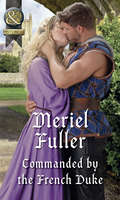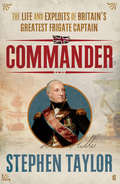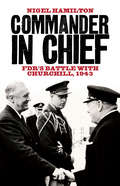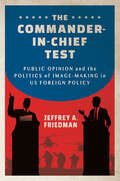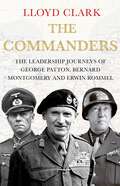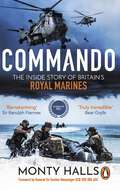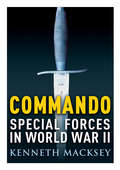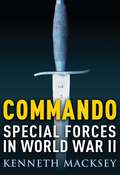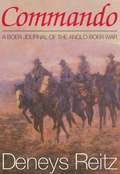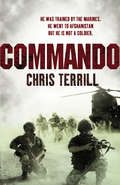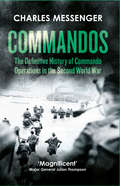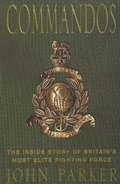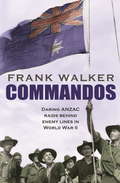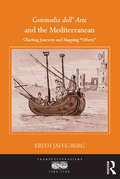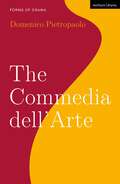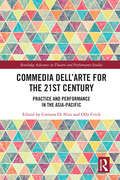- Table View
- List View
Commanded By The French Duke: The Innocent And The Outlaw Commanded By The French Duke Claiming The Chaperon's Heart (Mills And Boon Historical Ser.)
by Meriel FullerOne knight to capture her heart! Alinor of Claverstock takes her life in her hands when she rescues Bianca d’Attalens from her stepmother’s evil clutches. But when Alinor encounters Bianca’s handsome brother, Guilhem, Duc d’Attalens, it’s not just her life that’s in danger.
Commander: The Life and Exploits of Britain's Greatest Frigate Captain
by Stephen TaylorEdward Pellew, captain of the legendary Indefatigable, was quite simply the greatest frigate captain in the age of sail. An incomparable seaman, ferociously combative yet chivalrous, a master of the quarterdeck and an athlete of the tops, he was as quick to welcome a gallant foe into his cabin as to dive to the rescue of a man overboard. He is the likely model for the heroic but all-too-human Jack Aubrey in Patrick O'Brian's novels.Pellew was orphaned at eight, but fought his way from the very bottom of the Navy to fleet command and a viscountcy. Victories and eye-catching feats won him a public following. Yet as an outsider with a gift for antagonizing his better-born peers, he made powerful enemies. Redemption came with his last command, when he set off to do battle with the Barbary States and free thousands of European slaves. Contemporary opinion held this to be an impossible mission, and Pellew himself, in leading from the front in the style of his direct contemporary Nelson, did not expect to survive.Pellew's humanity as much as his gallantry, fondness for subordinates and blind love for his family, and the warmth and intimacy of his letters, make him a hugely engaging and sympathetic figure. In Stephen Taylor's magnificent new life he at last has the biography he deserves.
Commander in Chief: FDR's Battle with Churchill, 1943 (Fdr At War Ser. #2)
by Nigel HamiltonThe astonishing story of FDR's year-long battle with Churchill as World War II raged in Africa and Italy.In his masterly Mantle of Command, Nigel Hamilton made a powerful case for Franklin Delano Roosevelt as the brilliant war strategist whose towering importance to the Second World War is overlooked because of his early death. Now, in this second installment of his major trilogy, Hamilton reveals the remarkable truth - suppressed by Winston Churchill in his memoirs - of how Roosevelt battled with Churchill to maintain the strategy that would win the war.Roosevelt knew the Allies should take Sicily but avoid a wider battle in the Mediterranean, building experience but saving strength to invade France in early 1944. Churchill seemed to agree at Casablanca - only to undermine his own generals and the Allied command, testing Roosevelt's patience to the limit. Seeking to avoid the D-Day landings, Churchill made the disastrous decision to push the battle further into southern Europe, almost losing the war for the Allies. In a dramatic showdown, FDR finally set the course for victory by making the ultimate threat.Challenging seven decades of conventional wisdom about not one but two world leaders, Commander in Chief draws on extraordinary new archive material to delve further into the minds and actions of the men who led the Allied powers in the crucial year that decided the outcome of World War II.
The Commander-in-Chief Test: Public Opinion and the Politics of Image-Making in US Foreign Policy (Cornell Studies in Security Affairs)
by Jeffrey A. FriedmanIn The Commander-in-Chief Test, Jeffrey A. Friedman offers a fresh explanation for why Americans are often frustrated by the cost and scope of US foreign policy—and how we can fix that for the future.Americans frequently criticize US foreign policy for being overly costly and excessively militaristic. With its rising defense budgets and open-ended "forever wars," US foreign policy often appears disconnected from public opinion, reflecting the views of elites and special interests rather than the attitudes of ordinary citizens.The Commander-in-Chief Test argues that this conventional wisdom underestimates the role public opinion plays in shaping foreign policy. Voters may prefer to elect leaders who share their policy views, but they prioritize selecting presidents who seem to have the right personal attributes to be an effective commander in chief. Leaders then use hawkish foreign policies as tools for showing that they are tough enough to defend America's interests on the international stage. This link between leaders' policy positions and their personal images steers US foreign policy in directions that are more hawkish than what voters actually want.Combining polling data with survey experiments and original archival research on cases from the Vietnam War through the occupations of Iraq and Afghanistan, Friedman demonstrates that public opinion plays a surprisingly extensive—and often problematic—role in shaping US international behavior. With the commander-in-chief test, a perennial point of debate in national elections, Friedman's insights offer important lessons on how the politics of image-making impacts foreign policy and how the public should choose its president.
Commander (Jack Lark, Book 10)
by Paul Fraser Collard'Like all the best vintages Jack Lark has aged to perfection. Scarred, battered and bloody, his story continues to enthral' ANTHONY RICHESA true leader serves his men. The Jack Lark series is historical military fiction at its finest, for fans of Bernard Cornwell's Sharpe series, Matthew Harffy and Patrick O'Brian. This is the tenth adventure featuring Jack Lark: soldier, leader, imposter.Egypt, 1869. Jack Lark has reinvented himself once more. Working as an unofficial agent for the Consul-General, he moves among the most powerful men in Cairo. But when the opportunity arises to join legendary explorer Sir Samuel White Baker on his expedition into the Sudan, Jack can't resist a new adventure.Jack assumes command of an elite cadre to protect the fleet of vessels. But, as they move down the Nile, Jack and his men soon find themselves in a land where the rule of law means nothing, and those who wield power will do anything to keep it. And when a new friend seeks Jack's help, Jack must decide where his loyalties truly lie . . .Praise for the Jack Lark series:'Brilliant' Bernard Cornwell'Enthralling' The Times'Bullets fly, emotions run high and treachery abounds... exceptionally entertaining historical action adventure' Matthew Harffy'Expect ferocious, bloody action from the first page' Ben Kane'You feel and experience all the emotions and the blood, sweat and tears that Jack does... I devoured it in one sitting' Parmenion Books
The Commanders: The Leadership Journeys of George Patton, Bernard Montgomery and Erwin Rommel
by Lloyd ClarkBorn between 1885 and 1891, George Patton, Bernard Montgomery and Erwin Rommel all participated in the First World War and, like millions of others, were so affected by their wartime experiences that it became a fundamental influence on their lives. Yet none of the men were dissuaded by the carnage from seeking military careers when the guns finally fell silent. Each became wholly dedicated to the profession of arms and, being exceptional officers and leaders, they prospered.Despite the broad similarities between them, there were some marked differences in their approach to leadership due to the individuality bestowed on them from their genes, upbringing, life experience and relationships. Triumph reveals how these stimuli created three unique personalities which, in turn, each man came to draw from when they became among the most prominent officers in their armies.Exploring the many and various influences that shaped these three officers as men, as soldiers and, principally, as leaders, Lloyd Clark tracks their progress - through war and peace - all the way up to their final confrontation on the battlefields of the Second World War.
The Commanders: Australian Military Leadership in the Twentieth Century (Routledge Libary Editions: Historical Security)
by D. M. HornerOriginally published in 1984, this book tells the story of sixteen of Australia’s most eminent military men, as they performed under the stress of strategy-making and in the heat of battle. In scrutinising critical periods in the careers of such men as Brudenell White, Chauvel, Monash, Gordon Bennett, Blamey and Scherger, it addresses a number of fascinating questions: Is there an Australian style of command? How well have Australian officers been prepared for high command? How have Australian commanders handled the problems of coalition way or co-operation with allies? How have political direction, organisational structures and entrenched defence policy affected the performance of commanders in the field? Each re-evaluation compares performance with reputation. Some of the figures examined are familiar (What was the real basis of Monash’s reputation as a commander? Was Blamey worthy of the field-marshal’s baton?); some are given an appraisal long denied them. This roll-call of some of Australia’s greatest warriors presents a fascinating picture of the realities of war at the top. Each of the sixteen lives examined presents a revealing account of the conditions under which crucial military decisions are made and carried out – on the battlefield, at headquarters, in victory and defeat. The Commanders will appeal not only to students of military affairs but to everyone interested in Australian history and biography.
The Commanders: Australian Military Leadership in the Twentieth Century (Routledge Libary Editions: Historical Security)
by D. M. HornerOriginally published in 1984, this book tells the story of sixteen of Australia’s most eminent military men, as they performed under the stress of strategy-making and in the heat of battle. In scrutinising critical periods in the careers of such men as Brudenell White, Chauvel, Monash, Gordon Bennett, Blamey and Scherger, it addresses a number of fascinating questions: Is there an Australian style of command? How well have Australian officers been prepared for high command? How have Australian commanders handled the problems of coalition way or co-operation with allies? How have political direction, organisational structures and entrenched defence policy affected the performance of commanders in the field? Each re-evaluation compares performance with reputation. Some of the figures examined are familiar (What was the real basis of Monash’s reputation as a commander? Was Blamey worthy of the field-marshal’s baton?); some are given an appraisal long denied them. This roll-call of some of Australia’s greatest warriors presents a fascinating picture of the realities of war at the top. Each of the sixteen lives examined presents a revealing account of the conditions under which crucial military decisions are made and carried out – on the battlefield, at headquarters, in victory and defeat. The Commanders will appeal not only to students of military affairs but to everyone interested in Australian history and biography.
The Commander's Dilemma: Violence and Restraint in Wartime
by Amelia Hoover GreenWhy do some military and rebel groups commit many types of violence, creating an impression of senseless chaos, whereas others carefully control violence against civilians? A classic catch-22 faces the leaders of armed groups and provides the title for Amelia Hoover Green’s book. Leaders need large groups of people willing to kill and maim—but to do so only under strict control. How can commanders control violence when fighters who are not under direct supervision experience extraordinary stress, fear, and anger? The Commander’s Dilemma argues that discipline is not enough in wartime. Restraint occurs when fighters know why they are fighting and believe in the cause—that is, when commanders invest in political education.Drawing on extraordinary evidence about state and nonstate groups in El Salvador, and extending her argument to the Mano River wars in Liberia and Sierra Leone, Amelia Hoover Green shows that investments in political education can improve human rights outcomes even where rational incentives for restraint are weak—and that groups whose fighters lack a sense of purpose may engage in massive violence even where incentives for restraint are strong. Hoover Green concludes that high levels of violence against civilians should be considered a "default setting," not an aberration.
Commando: The Inside Story of Britain’s Royal Marines
by Monty Halls'There is only one colour that matters, one that unites us all. And that colour is green.'The Royal Marine Commandos have become a byword for elite raiding skills and cutting-edge military operations. They are globally renowned, yet shrouded in mystery. With unique insight and authority, Commando captures the essence and heart of this revered military unit then and now, exploring their role patrolling the high seas and policing coastlines around the globe, and revealing their rich history and what it means to win and wear the legendary green beret.With full and exclusive access to every level of the organisation, author and former Royal Marine Monty Halls tells the real stories of extraordinary individuals through a period of historic global unrest: from Future Commando forces on high-profile drug busts to Mountain Leaders training across glaciers north of the Arctic Circle; from medics who serve as global first responders in conflict to wounded veterans raising vast sums to support their brethren in the Corps Family. These are the modern vanguard of a legendary unit, descendants of the misfits and eccentrics who were so effective and feared in WW2 that Hitler famously ordered them to be shot on sight.Commando is an unforgettable glimpse into a rarified world of danger, drama, and valour.
Commando: Special Forces in World War II (Osprey Digital Generals Ser.)
by Kenneth MackseyCommando', the history Commandos and small-scale raids during World War II, is a gripping narrative, tracing the actions of the fearless men who served as Allied commandos for the Combined Operations department during the war. Kenneth Macksey offers the details of St Nazaire, Bruneval, Dieppe as well as the key players, such as Stirling, Lovat and Carlson. Macksey skilfully provides a study of the lesser-known figures, such as Edson, Appleyard and Pickney, bringing to life their courage and determination while celebrating the sailors who enabled the raiders to reach their destinations.
Commando: Special Forces in World War II
by Kenneth MackseyCommando', the history Commandos and small-scale raids during World War II, is a gripping narrative, tracing the actions of the fearless men who served as Allied commandos for the Combined Operations department during the war. Kenneth Macksey offers the details of St Nazaire, Bruneval, Dieppe as well as the key players, such as Stirling, Lovat and Carlson. Macksey skilfully provides a study of the lesser-known figures, such as Edson, Appleyard and Pickney, bringing to life their courage and determination while celebrating the sailors who enabled the raiders to reach their destinations.
Commando: Winning World War II Behind Enemy Lines
by James OwenJune 1940: As Britain's soldiers limped home from Dunkirk, a maverick Army officer was already devising a bold plan to hit back at the enemy. His idea was to revolutionise military thinking and change the face of warfare for ever. Relying as much on stealth and guile as on courage and stamina, the Commandos brought to the battlefield the skills of the guerrilla. Trained by an unconventional band of experts, and led by a big-game hunter, a film star, a Highland chief and an eccentric wielding a bow and arrow, they became the spearhead of the Allied drive for victory.Weaving together official documents, new research and veterans' own accounts, Commando reveals for the first time the exhilarating full story of WWII's most formidable fighting force.
Commando: A Boer Journal Of The Anglo-Boer War
by Deneys ReitzIn 1899, seventeen-year-old Deneys Reitz enlisted in the Boer army to fight the British. He had learnt to ride, shoot and swim almost as soon as he could walk. The skills and endurance he had acquired were more than put to the test during the war. Commando is his classic account of guerrilla warfare during the Anglo-Boer War (1899-1902), during which Reitz served in a Boer commando consisting mainly of farmers on horseback using their own guns. Written while in exile in Madagascar and originally published in 1929, the book covers the early engagements in Natal, the battle of Spion Kop and General Smuts' audacious guerrilla campaign deep into the Cape Colony. The straightforward narrative of his experiences is both a classic of true-life adventure, and an unforgettable picture of mobile guerrilla warfare. The book contains a preface by South African statesman JC Smuts and an introduction by the historian Thomas Pakenham.
Commando
by Chris TerrillChris Terrill is a man in search of his limit. He's 55 years old. He is not a soldier. He is being trained by the Royal Marines and he is going to Afghanistan. The only difference is that instead of a gun, Chris will be holding a camera and filming the whole ordeal for a major TV series.The Royal Marines Commando training base in Lympstone Devon, has a famous motto: '99.9% need not apply'. Of those who start training, after a very tough selection process, nearly 50% fail to make it through the most gruelling physical tests of any armed forces in the world in an eight month training regime. The elite who do eventually pass out are generally eighteen years old and at the peak of physical condition. But Chris Terrill is the exception: this book will tell of his heroic struggle to become the oldest man to win the coveted Royal Marines Commando Green Beret and enter the record books.And after six months of hell, what next? Chris will follow the raw recruits on a tour to Southern Afghanistan. He will tell the story in book and film of the fears and hopes of the youngsters as they are plunged into one of the planet's most dangerous wars in the outlaw mountain terrain of Helmand Province. He will tell of ferocious battles against the Taliban, of firefights, of jaw-dropping heroism, British sang froid and humour and tragedy as causalities are suffered -- all from the unique perspective of a civilian who has achieved the ultimate accolade: to be accepted as an honorary Royal Marines Commando. Commando is a brilliant account of modern war on the front line.
Commando Medic: Doc Harden VC
by Stephen J. SnellingEric Harden was the only British army medic to be awarded the nation’s highest honour for battlefield bravery during the Second World War and remains the only rank and file member of the Royal Army Medical Corps to be recognised by the award of the Victoria Cross. As a pre-war member of the St John Ambulance, he saw service during the 1940-41 Blitz and later volunteered for the Commandos, under-going the same rigorous training as the fighting men before being attached to 45 Royal Marine Commando. He landed with his unit on D-Day and was involved in some of the fiercest fighting of the Normandy campaign. During a bitter battle on the Dutch-German border, Harden, known throughout his unit as Doc, was killed saving the lives of wounded men trapped in no-man’s land. Commenting on the posthumous award in a speech to the House of Commons, the Secretary of State for War, the Rt Hon James Grigg was sufficiently moved by his selfless actions to say: “I do not remember ever reading anything more heroic.”
Commandos: The Definitive History Of Commando Operations In The Second World War
by Charles MessengerThe definitive and thrilling history of those who wore the famous green beret.
Commandos: The Inside Story Of A Force For The Future
by John ParkerThe Commandos were Britain's first-ever special forces, formed in 1940 using volunteers from all three services. After the war, Commando units of the Royal Marines engaged in virtually every military scenario involving British troops from 1945 to the present day. They became the elite of the British 'ready-to-go' forces, capable of deploying at a moment's notice to any trouble spot in the world. In this latest book in John Parker's acclaimed series on British military activity, dramatically recalled in their own words by men who were there, he recounts the major events in the 60-year history of British Commando forces.
Commandos: Heroic and Deadly ANZAC Raids in World War II
by Frank WalkerAmazing revelations and extraordinary exploits of Australia's elite secret warriors.There was something unique about Australians and New Zealanders in war that prompted World War II Allied commanders to turn to ANZAC soldiers, sailors and airmen to carry out the most dangerous and virtually impossible missions behind enemy lines.Paddling canoes 4,000 kilometres to attack enemy ships in Singapore; lightning raids on Rommel's forces in the deserts of North Africa. Flying bombers at tree-top level deep into Nazi Germany to destroy vital targets; rescuing sultans and future US presidents from under the noses of the Japanese and playing crucial roles in the greatest commando raid of the war at St Nazaire - the Aussies and Kiwis were there.The special forces showed incredible bravery in the face of overwhelming odds. They were determined to complete their missions. Often alone and far behind enemy lines,they demonstrated resourcefulness, spirit and a humanity that inspired others to follow them.Frank Walker, author of bestselling books on the Vietnam War and the British atomic tests in Australia, brings to life the amazing exploits and extraordinary stories of this select band of heroes..
Commedia dell' Arte and the Mediterranean: Charting Journeys and Mapping 'Others' (Transculturalisms, 1400-1700)
by Erith Jaffe-BergDrawing on published collections and also manuscripts from Mantuan archives, Commedia dell' arte and the Mediterranean locates commedia dell' arte as a performance form reflective of its cultural crucible in the Mediterranean. The study provides a broad perspective on commedia dell’ arte as an expression of the various cultural, gender and language communities in Italy during the early-modern period, and explores the ways in which the art form offers a platform for reflection on power and cultural exchange. While highlighting the prevalence of Mediterranean crossings in the scenarios of commedia dell' arte, this book examines the way in which actors embodied characters from across the wider Mediterranean region. The presence of Mediterranean minority groups such as Arabs, Armenians, Jews and Turks within commedia dell' arte is marked on stage and 'backstage' where they were collaborators in the creative process. In addition, gendered performances by the first female actors participated in 'staging' the Mediterranean by using the female body as a canvas for cartographical imaginings. By focusing attention on the various communities involved in the making of theatre, a central preoccupation of the book is to question the dynamics of 'exchange' as it materialized within a spectrum inclusive of both cultural collaboration but also of taxation and coercion.
Commedia dell' Arte and the Mediterranean: Charting Journeys and Mapping 'Others' (Transculturalisms, 1400-1700)
by Erith Jaffe-BergDrawing on published collections and also manuscripts from Mantuan archives, Commedia dell' arte and the Mediterranean locates commedia dell' arte as a performance form reflective of its cultural crucible in the Mediterranean. The study provides a broad perspective on commedia dell’ arte as an expression of the various cultural, gender and language communities in Italy during the early-modern period, and explores the ways in which the art form offers a platform for reflection on power and cultural exchange. While highlighting the prevalence of Mediterranean crossings in the scenarios of commedia dell' arte, this book examines the way in which actors embodied characters from across the wider Mediterranean region. The presence of Mediterranean minority groups such as Arabs, Armenians, Jews and Turks within commedia dell' arte is marked on stage and 'backstage' where they were collaborators in the creative process. In addition, gendered performances by the first female actors participated in 'staging' the Mediterranean by using the female body as a canvas for cartographical imaginings. By focusing attention on the various communities involved in the making of theatre, a central preoccupation of the book is to question the dynamics of 'exchange' as it materialized within a spectrum inclusive of both cultural collaboration but also of taxation and coercion.
The Commedia dell’Arte (Forms of Drama)
by Domenico PietropaoloWhat were the origins of commedia dell'arte and how did it evolve as a dramatic form over time and as it spread from Italy? How did its relationship to the ruling ideology of the day change during the Enlightenment? What is its legacy today? These are just some of the questions addressed in this authoritative overview of the dramatic, ideological and aesthetic form of commedia dell'arte. The book's 3 sections examine the changing role of performers and playwrights, improvisatory scenarios and scripted performance, and its function as a vehicle for social criticism, to offer readers a clear understanding of commedia dell'arte's evolution in Renaissance Italy and beyond. This study throws new light on the role of women performers; on the changing ideological discourse of commedia dell'arte, which included social reform and, later, conservatism as well as the alienation of ethnic minorities in complicity with its audience; and on its later adaptation into hybrid forms including grotesque dance and the giullarata typified by the work of Dario Fo.
The Commedia dell’Arte (Forms of Drama)
by Domenico PietropaoloWhat were the origins of commedia dell'arte and how did it evolve as a dramatic form over time and as it spread from Italy? How did its relationship to the ruling ideology of the day change during the Enlightenment? What is its legacy today? These are just some of the questions addressed in this authoritative overview of the dramatic, ideological and aesthetic form of commedia dell'arte. The book's 3 sections examine the changing role of performers and playwrights, improvisatory scenarios and scripted performance, and its function as a vehicle for social criticism, to offer readers a clear understanding of commedia dell'arte's evolution in Renaissance Italy and beyond. This study throws new light on the role of women performers; on the changing ideological discourse of commedia dell'arte, which included social reform and, later, conservatism as well as the alienation of ethnic minorities in complicity with its audience; and on its later adaptation into hybrid forms including grotesque dance and the giullarata typified by the work of Dario Fo.
Commedia dell’Arte for the 21st Century: Practice and Performance in the Asia-Pacific (Routledge Advances in Theatre & Performance Studies)
by Corinna Di Niro Olly CrickThis book discusses the evolution of Commedia dell’Arte in the Asia-Pacific where through the process of reinvention and recreation it has emerged as a variety of hybrids and praxes, all in some ways faithful to the recreated European genre. The contributors in this collection chart their own training in the field and document their strategies for engaging with this form of theatre. In doing so, this book examines the current thoughts, ideas, and perceptions of Commedia – a long-standing theatre genre, originating in a European-based collision between neo-classical drama and oral tradition. The contributing artists, directors, teachers, scholars and theatre-makers give insight into working styles, performance ideas, craft techniques and ways to engage an audience for whom Commedia is not part of their day-to-day culture. The volume presents case studies by current practitioners, some who have trained under known Commedia ‘masters’ (e.g. Lecoq, Boso, Mazzone-Clementi and Fava) and have returned to their country of origin where they have developed their performance and teaching praxis, and others (e.g. travelling from Europe to Japan, Thailand, Singapore and China) who have discovered access points to share or teach Commedia in places where it was previously not known. This book will be of great interest to students and scholars in Performing arts, Italian studies, and History as well as practitioners in Commedia dell’Arte.
Commedia dell’Arte for the 21st Century: Practice and Performance in the Asia-Pacific (Routledge Advances in Theatre & Performance Studies)
by Corinna Di Niro Olly CrickThis book discusses the evolution of Commedia dell’Arte in the Asia-Pacific where through the process of reinvention and recreation it has emerged as a variety of hybrids and praxes, all in some ways faithful to the recreated European genre. The contributors in this collection chart their own training in the field and document their strategies for engaging with this form of theatre. In doing so, this book examines the current thoughts, ideas, and perceptions of Commedia – a long-standing theatre genre, originating in a European-based collision between neo-classical drama and oral tradition. The contributing artists, directors, teachers, scholars and theatre-makers give insight into working styles, performance ideas, craft techniques and ways to engage an audience for whom Commedia is not part of their day-to-day culture. The volume presents case studies by current practitioners, some who have trained under known Commedia ‘masters’ (e.g. Lecoq, Boso, Mazzone-Clementi and Fava) and have returned to their country of origin where they have developed their performance and teaching praxis, and others (e.g. travelling from Europe to Japan, Thailand, Singapore and China) who have discovered access points to share or teach Commedia in places where it was previously not known. This book will be of great interest to students and scholars in Performing arts, Italian studies, and History as well as practitioners in Commedia dell’Arte.
